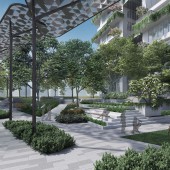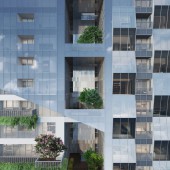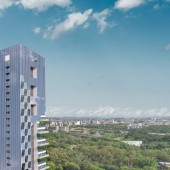Sky Jade Residence by Golden Jade |
Home > Winners > #157407 |
 |
|
||||
| DESIGN DETAILS | |||||
| DESIGN NAME: Sky Jade PRIMARY FUNCTION: Residence INSPIRATION: Sky Jade is an architectural development project located in Taichung City, Taiwan. Adopting a digital architectural design approach, Golden Jade evaluates various aspects of environmental living, challenging the traditional framework of designing buildings solely through 2D models. By utilizing digital parametric technology, it creates a three-dimensional spatial design model and simulates various data such as environmental conditions, climate, energy efficiency, natural lighting, and structural mechanics. The aim is to achieve a rational composition of space, materials, and structure. In order to realize a low-carbon aesthetic architecture that harmonizes with the natural environment, the project integrates technology into daily life. It transforms user needs such as intelligence, epidemic prevention, and energy sustainability into tangible values for living. Unlike conventional developments that often prioritize maximizing building coverage on limited sites, this project takes a distinctive approach. Preserving a harmonious relationship with the surrounding environment, the design prioritizes allocating space for green. This dedication even extends seamlessly to the building's facade. UNIQUE PROPERTIES / PROJECT DESCRIPTION: Sky Jade features a 360-degree curtain glass design complemented by a 7-degree glass inclination. The use of light refraction angles presents a faceted appearance reminiscent of gemstone cuts, allowing each facade to showcase a unique architectural expression. The Interior layout design incorporates four-sided natural lighting, promoting energy efficiency. It also provides the opportunity to appreciate the rich interplay of light and shadow introduced indoors at different times of the day. The building's exterior embraces a dynamic concept of blossoming, featuring a green cascading waterfall motif that transforms with the interplay of light and shadow. The greenery from Tunghai University reflects onto the glass curtain wall, creating a lively 'green movement' and symbolizing an atmosphere of 'open-mindednes OPERATION / FLOW / INTERACTION: Design Highlights: a. The project prioritizes green spaces and allocates more areas for public use within the limited site. Instead of maximizing building coverage, the emphasis is on preserving greenery and prominently showcasing it in the building's exterior. b. Consideration is given to the growth conditions of plants within the building, taking factors such as site orientation and wind pressure on the structure into account. Thoughtful planning involves extending plant-filled balconies from the ground level and integrating sky gardens. c. The 7-degree sloped glass curtain wall creates a curved appearance reminiscent of diamond facets. With variations in sunlight, weather, and reflections from clouds, it presents different scenic views. PROJECT DURATION AND LOCATION: This project involves a 24-story residential building, with residential units located on the 2nd floor and above, and public amenities on B2, 1F, MF, R1F, and R2F. The site is situated at the corner of Taiwan Boulevard and Yumen Road. The project commenced in April 2023 and is anticipated to be completed by October 2029. FITS BEST INTO CATEGORY: Architecture, Building and Structure Design |
PRODUCTION / REALIZATION TECHNOLOGY: Digital Architecture: a. Leveraging digital architectural design, a professional team aligns the glass curtain angles with local sunlight conditions, transforming them into logical elements for aesthetic variations in the building's appearance. b. Sunlight relationships and wind field experiments are converted into data through digital analysis, providing a foundational basis for the arrangement of landscape orientations. Smart Building Management: a. Rainwater Harvesting and Reuse By converting large areas of structural raft foundations into water storage spaces and utilizing various water resources, such as rain, we aim to provide additional supply for extensive greenery. b. Energy-Saving Plan In our energy-saving plan, we are experimenting with an energy storage and recovery system for high-speed elevators at the existing site (Sky Green), collecting actual data, and assessing the efficiency of power conversion. Additionally, through a solar power scheme, we aim to provide electricity for localized public spaces within the building 24 hours a day. c. Safety/Health Management Measures • Non-touch calling (elevator) • Sterilization and purification device (elevator) • Residential VAF (Variable Airflow Condition) system • Reserved piping for charging stations in parking spaces (electric vehicles) • EATG vehicle access control SPECIFICATIONS / TECHNICAL PROPERTIES: This project involves a 24-story residential building, with residential units located on the 2nd floor and above, and public amenities on B2, 1F, MF, R1F, and R2F. The site is situated at the corner of Taiwan Boulevard and Yumen Road, overlooking the expansive 400,000-square-meter forested area of Tunghai University. Taiwan Boulevard, with a total length of 24.2 kilometers, serves as a key transportation artery in Taichung City, connecting Taichung Railway Station to the Taichung Port area. It forms a vibrant living zone that converges technology, commerce, and healthcare. The project includes an arrangement of a sky garden every three floors, with eight units having private one. Diverse plant landscapes and seasonal views create a gathering space for residents and birds seeking relaxation, connecting community relationships among residents. Teeming with perpetual natural vitality, the garden offers a serene flow of sunlight and fresh air —a perfect path to embracing nature. Floors: 24F / B5 Lot Size: 3074.92 square-meter Living Space per Household: 188-209 square-meter TAGS: A, Digital Architectural Design B, low-carbon aesthetic architecture C, Energy Sustainability D, Curtain Glass Design E, Sustainable Coexistence with Nature. RESEARCH ABSTRACT: Innovative Technology And Methods: Digital architecture is not only a technological innovation in architectural creation but also a carrier of sustainable living in the future. With the mindset of "form follows efficiency," digital architecture considers various aspects of environmental life assessment during the formation of buildings. It overturns the traditional approach of using two-dimensional models and non-linear frameworks, liberating the possibilities of space and form. By utilizing precise digital algorithm technology, it creates three-dimensional spatial design models and incorporates various digital parameters such as environment, climate, energy efficiency, natural lighting, and structural mechanics. This integration involves complex and diverse geometric designs, progressing from drawings, images, models, animations, virtual reality, etc. The goal is to achieve a rational composition of space, materials, and structure, resulting in a low-carbon aesthetic architecture that adapts harmoniously to the natural environment. Furthermore, it integrates technological aspects of life, transforming user demands such as intelligence, epidemic prevention, and sustainable energy into tangible life values. Environmentally friendly and non-toxic construction materials are used throughout the construction process to reduce the Earth's environmental impact, and energy-saving and energy-storage devices are incorporated.Achieve CHALLENGE: Integrating an international team was crucial as this project serves as a flagship for our brand, warranting meticulous attention. Throughout the design phase, numerous revisions and iterations were undertaken.Challengi ADDED DATE: 2024-01-31 01:05:25 TEAM MEMBERS (6) : Architecture Design , Joyce Yang, Architect Jung-Chiang Hsu’s Office, , Builder, and Golden Jade Construction & Development Corp. IMAGE CREDITS: Image #1, Image #2, Image #3, Image #4, Image #4 , Image #5 Credits: Modeling Artist ,Charming3d ,2023 Video Credits: Modeling Artist ,Charming3d ,2023 PATENTS/COPYRIGHTS: This design has not yet applied for a patent. |
||||
| Visit the following page to learn more: https://www.goldenjade.com.tw/works_deta |
|||||
| AWARD DETAILS | |
 |
Sky Jade Residence by Golden Jade is Winner in Architecture, Building and Structure Design Category, 2023 - 2024.· Press Members: Login or Register to request an exclusive interview with Golden Jade. · Click here to register inorder to view the profile and other works by Golden Jade. |
| SOCIAL |
| + Add to Likes / Favorites | Send to My Email | Comment | Testimonials | View Press-Release | Press Kit |







